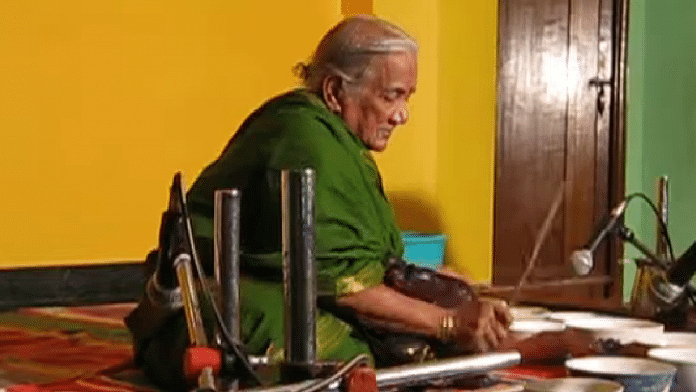Draped in a Madisar saree, sitting cross-legged, and surrounded by porcelain bowls arranged in a semicircle, an elderly woman flicks at the edge of the bowls with two bamboo sticks held in each hand, producing ‘water waves of sounds’ or ‘jaltarangams’ with agility belying her age.
Meet Seetha Doraiswamy — a renowned Carnatic instrumentalist, regarded as the last recognised female exponent of the Indian percussion instrument that is going into obscurity.
Delighting audiences for over four decades with the captivating euphony of the jaltarangam, Seetha Doraiswamy kept the dying music astir.
Not just that, she presented a case for female representation in music. She made a comeback to pursue her passion at the age of 41 after a halt of over 25 years owing to married life and family obligations.
Recognising her contribution to the preservation of the jaltarangam, the government of Tamil Nadu awarded Doraiswamy with the Kalaimamani in 2001, the highest civilian award in the state. She has been the only recipient of the award as an exponent of the jaltarangam till today.
“It is time to bring to notice the fact that (Seetha) championed the cause of equal female representation during a time where our cultural norms may have not,” read the citation of the award.
The artist also became the first female musician to be awarded the Gold Medal of Honour in 1939 from The Music Academy, the first Carnatic music Institute, and to this day, remains the youngest woman to win it.
Also read: O.P. Nayyar, the untrained musical genius who was more than just a hit machine
Early childhood and tryst with the jaltarangam
Seethalakshmi Doraiswamy was born in Adachani, a village in the Tirunelveli district of then-Madras presidency on 27 January 1926.
Her interest in music began to blossom when her family moved to Madras when she was 10. It was at Prof. P. Sambamoorthy’s summer school of Indian music in 1937 when she first saw the jaltarangam. She found the sight of cups filled with water amusing and ‘couldn’t believe that you had to hit them’.
“I was only 10 then, and the dishes used by jaltarangam artists reminded me of the miniature vessels children use when they play ‘house’. Striking dishes containing water seemed a lot of fun,” Seetha Doraiswamy was quoted in The Hindu.
Choosing the jaltarangam and passing the ‘simple’ test
After excelling in the theoretical aspect of Carnatic music, the students in Prof. Sambamoorthy’s school could choose either the gottuvadhyam or the jaltarangam. For the jaltarangam, the school’s music teacher, Ramaniah Chettiar, was not quite convinced that there was a suitable candidate. Upon the insistence of Sambamoorthy, he agreed to entertain Seetha’s request to give it a try. He filled the cups with water, keeping them tuned to the notes of rāga Sankarabharanam and asked her to play rāga Mayamalvagowla.
“Simple” was her answer. “Increase the level of water in the cups representing ‘ri’ and `da,’ and you will get Mayamalavagowla”, she said. Having impressed her teachers, Doraiswamy was selected as a student and thus began her training.
Such was her passion to learn that she would trudge daily to Sambamoorthy’s house who owned the only jaltarangam set in that area. Later, he generously bought her a set of jaltarangam bowls to practice at home, out of which she could only preserve two as keepsakes.
Also read: Amitabh to Salman — this 29-year-old Sri Lankan singer got Indian stars grooving in 2021
Married at 14, mother to 10 and halt in music career
Seetha Doraiswamy’s life took a sudden change of direction, and she was married to a 27-year-old N. Doraiswamy Iyer at the age of 14 as per her parents’ wishes. However, her husband saw her yearning for music and helped her get enrolled in the Madras Music Academy where she studied under guru Valaadi Krishna Iyer.
Increasing responsibilities — she had 10 children in her marriage — over the next three decades kept her away from the instrument. Her life consequently became all about her children. The death of one of her sons left her shattered, and it wasn’t until 1968 that she decided to pick up her sticks to flick the water bowls once more upon encouragement from the family.
Rebirth of the relationship with the water waves
Seetha Doraiswamy regained her vigour with the ‘waves of water’ and became a jaltarangam artist at All India Radio at the age of 41 with her very first performance winning her adulations.
A 2005 article in The Hindu said, “At 79, Seetha Doraiswamy still wields the sticks with joyous abandon.” Her comeback was paradigm-changing for female representation in music.
Doraiswamy, however, saw herself as a traditionalist – a contented family woman – despite all her laurels. She didn’t see her achievement being anything remarkable or out of the ordinary.
She held such views despite her cosmopolitan image. The artist performed all over the world, amazing audiences from Muscat to the US.
Reviewing the concert that Seetha Doraiswamy gave in the US in 1990 and acknowledging how difficult it is to play the jaltarangam, The New York Times wrote, “Miss Doraiswamy has been playing the jaltarangam for more than 20 years, and in a two-and-a-half-hour concert in which she played a dozen ragas and variations on a few Western children’s tunes, she demonstrated not only a masterly technique but also some ingenious solutions to the problems the instrument poses.”
Doraiswamy nurtured the instrument “like a baby”. Fragile as they were, she used to carry the bowls herself in her hand luggage, often nursing them on her lap.
(Edited by Humra Laeeq)






